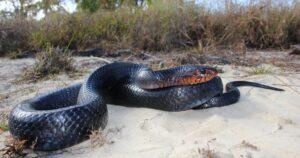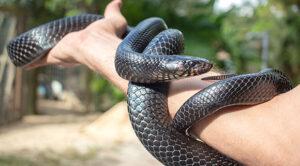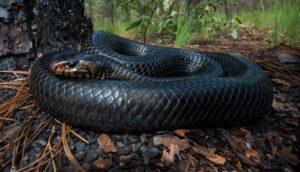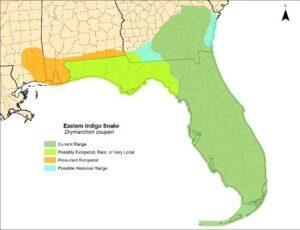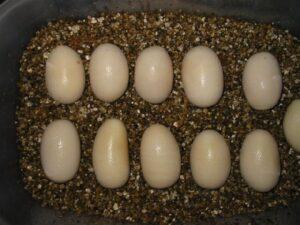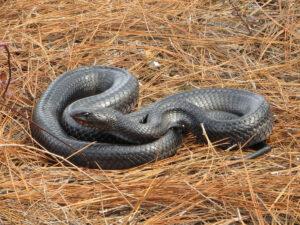The eastern indigo snake is a large non-venomous snake, the longest in North America. It is indigenous to the southeastern United States. American herpetologist and zoologist first described this snake in 1842.
While its generic name translates to the ‘lord of the forest,’ its species name is a Latinised version of James Hamilton Couper, the famous American planter’s surname. Couper was credited with bringing the type specimen from the southern part of the Altamaha River located in Georgia’s Wayne County. The snake is also called the blue indigo snake, blue gopher snake, indigo snake, blue bull snake, and black snake.
Scientific Classifications
- Suborder:Serpentes
- Family:Colubridae
- Genus:Drymarchon
- Species:D. couperi
Conservation Status
Description
Size
Unlike most other snakes, the eastern indigo males are bigger than their female counterparts. A mature male measures around 48-96 inches, while females reach 42-78 inches at maturity. The males appear heavier, too, weighing around 2 to 10 lbs, while the females weigh between 1.2 and 6 lbs. The longest recorded eastern indigo grew to 110 inches (including tail length). Those measuring above 102 inches are heavier, around 11 lb. The eastern indigo and eastern diamondback rattlesnake have a similar body mass. Yet, bigger specimens of the latter can outweigh the former.
Color and Appearance
They have a glossy black body with smooth iridescent scales appearing bluish or purplish when seen in sunlight. This also results in their common name, ‘indigo.’ Though the scales are smooth, the front part of some of them might be ridged or keeled.
Some specimens have a tan or reddish-orange coloration on their chin, cheek, and throat. Their belly is black or bluish-gray, and the anterior region appear reddish-orange or white.
The juvenile snakes have black glossy bodies similar to the adults. However, their heads might appear redder, and their body may have additional whitish-blue bands.
Are They Dangerous to Humans
These docile snakes are harmless to humans and rarely bite them. They turn aggressive only while competing with other male indigo snakes or their prey and can bite.
If agitated or threatened, they would pose a defensive behavior like vibrating their tail, flattening their neck, and hissing.
Eastern Indigo Snake at a Glance
Distribution
They occupy the southwestern parts of South Carolina, Florida, southern Alabama, southeastern Mississippi, and even Louisiana. Their close cousin, the Texas indigo snake, inhabits parts of Mexico and southern Texas.
Habitat
They are found near stream bottoms, dry meadows, flatwoods, cane fields, hammocks, riparian thickets, coastal dunes, cypress ponds, and freshwater marshes. In the northern part of their range, they mostly live in sandhills and shelter in the gopher tortoise burrows during winter. These burrows shield them from the extremities of temperature, predators, and fires. If the burrows aren’t found, they will resort to hollow logs, debris piles, or armadillo holes as an alternate option. In Georgia and Florida, they inhabit oak and pine plantations near trees like the scrub oak-longleaf pine, laurel oak, southern live oak, myrtle oak, and Chapman’s oak.
Lifespan
In the wild, their lifespan remains unrecorded; however, in captivity, these snakes survive for quite a long time, around 24-26 years.
Predators
Because of their large size, these snakes don’t have too many predators in the wild. Red-tailed hawks, alligators, domestic dogs, cats, and even bigger indigos may pose a threat to them. However, their biggest foe is humans, who often take these snakes from their wild habitat for pet trade considered illegal. Humans may even kill these snakes while trying to flush out rattlesnakes from the burrows of gopher tortoises.
Diet
They are carnivorous and feed on lizards, fish, toads, frogs, turtles, smaller mammals, birds, and their eggs. The eastern indigo also eats snakes, like the eastern diamondback and other North American rattlesnakes, as they are immune to the venom of the latter. They grab their prey using their jaws, press them against the ground, and chew until they stop struggling. The eastern indigo may even resort to an easier way of swallowing their prey alive, mostly the smaller ones. This is why they are often fed dead animals in captivity to prevent the snake from injuring itself while capturing prey.
Reproduction
Their mating season usually occurs between November and January. Still, it may start a month earlier, in October, and continue until March. The female indigos are oviparous, and their egg-laying season commences in late April, lasting till early June. The eggs laid in a clutch of 4-14 after a 3-month incubation period measure 75-100mm in length and 27-32 mm in width and hatch from midsummer – early fall. The eastern indigo snakes attain sexual maturity a little late when they are 3-5 years of age and measure around 5-6 feet. They can retain their sperm for a long time, up to 4 years. So, the females can choose the time of releasing their sperm for fertilizing their eggs.
Similar Species
They are smaller, thinner, and have a duller black coloration than the eastern indigo. Their throat and chin appear white against the reddish-orange color of the indigo snake.
Coachwhip Snake
While the eastern indigo is all black, the coachwhip has a tan body and black head and neck.
Texas Indigo Snake
They appear black with salmon-pink undersides.
Pet Care Sheet
They are docile and look attractive, being a preferred pet choice by many. However, keeping them without a permit in some states is considered illegal because of their protected status. Civil violation can lead to a fine of around $25000, while criminal offenses can cost a penalty of up to $50,000 and/or imprisonment. They aren’t readily available and come for $800-$1000.
Housing
They require a large enclosure of 6’L x 3’W x 3’H.
Temperature
A preferable temperature range for their enclosure is from 70-75°F, with an average humidity of around 60-80%.
Substrate
Substrates of soil and leaf litter are needed for their dwelling.
Diet
The juveniles should be fed every 3 to 5 days and the adults once in a 7-10 day span. One can feed rats, mice, chicks, quails, green anole, smaller snakes, and frogs to replicate the indigo snake’s diverse diet in the wild. They don’t need dietary supplements but giving them once in a while may prevent these snakes from being nutrient deficient. Don’t miss out keeping a large water bowl in its enclosure for the snake to drink and soak itself.
Conservation
Though the IUCN assesses the eastern indigo snake as Least Concern, it is federally threatened in Florida and Georgia. The ADCNR, Alabama’s conservation department has enlisted it as extirpated within the bounds of the state. A project launched by conservationists in Alabama in 2006 yielded positive results, with rare eastern indigo spotted in March 2022, the second in 60 years.
Interesting Facts
- Hunter S. Thompson, an American journalist, owned the eastern indigo. In his book Hell’s Angels, he pens down his experience. One evening in 1966, he had left his snake in a cardboard box along with a mouse s its food at the editor’s office of Random House. The mouse nibbled through the box, and both animals eventually escaped. In an unfortunate incident, the night watchman beat the snake to death.
Source
fws.gov, nfwf.org, edis.ifas.ufl.edu, encyclopediaofalabama.org, kingsnake.com, psychoticnature.com

